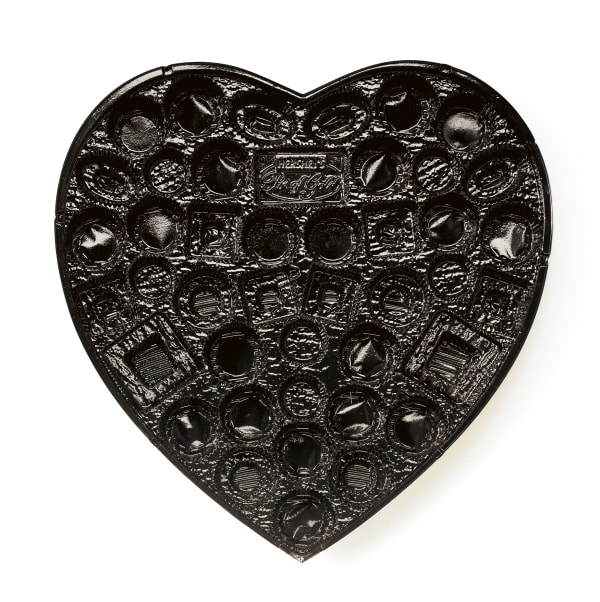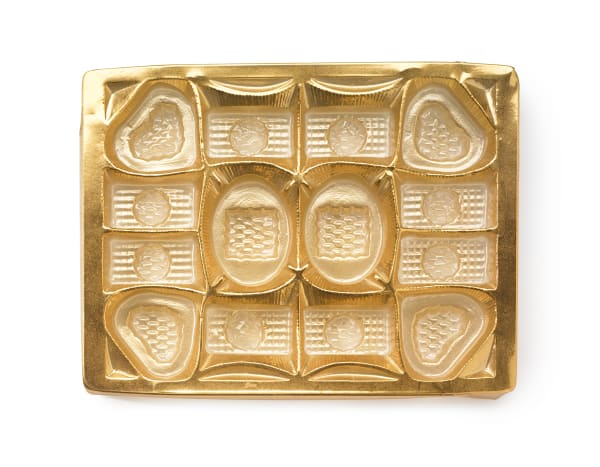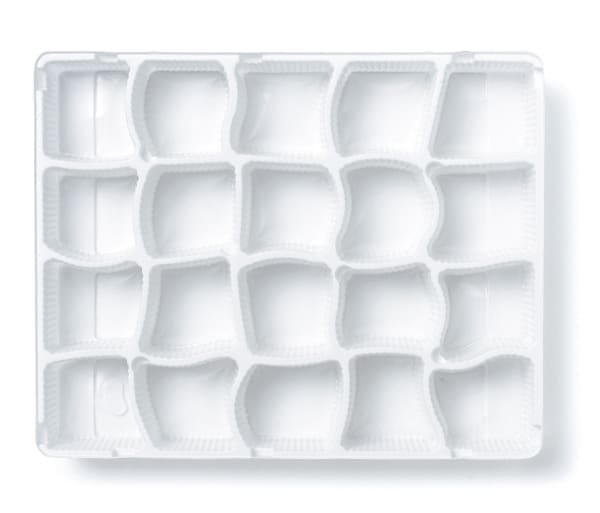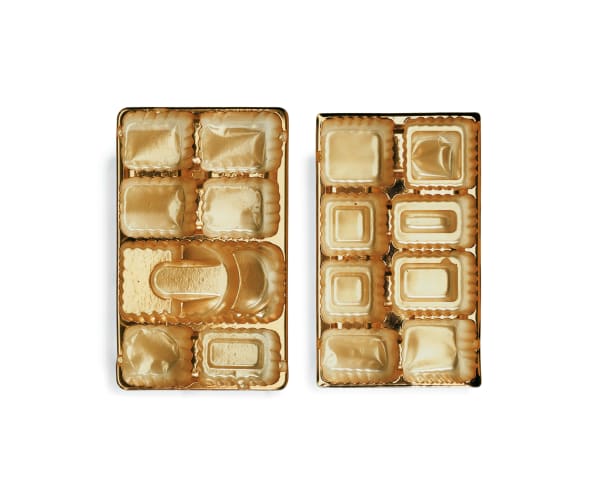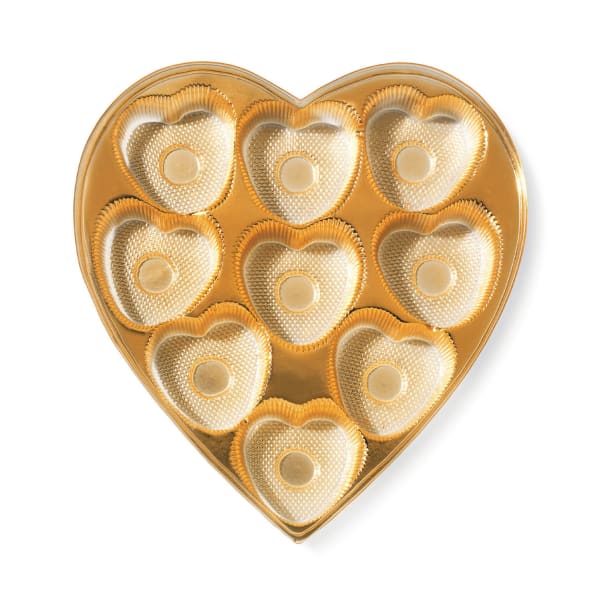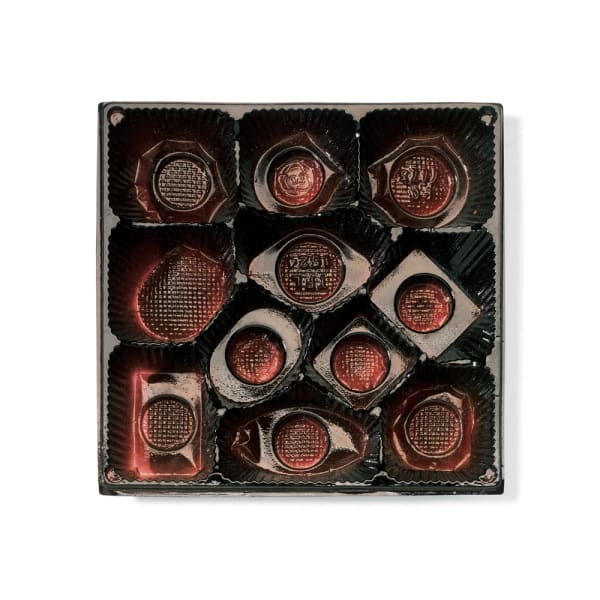Candy Trays 2002
"In Godiva 2 (2002), Chuck Ramirez photographed a golden plastic candy tray. True to form, Ramirez often took on thrown-away or partially consumed things as his subject matter. The half-eaten foods in Vegan from his Trash Bag series (1998), the beaten papier-mâché detritus of the Piñata series (2002) and leftover beans and taco wrappers in Tex-Mex from the Seven Days series (2004) are other examples. The explicitly temporary object is one of Ramirez’s leitmotifs; though, of course, there are others.
Godiva 2 holds the luscious color and shininess of commercial advertising, a connection that makes sense considering Ramirez’ early training in graphic design. Similarly advertising-like are his consumable or partly-consumed subjects; the gold of Godiva chocolate trays is one way that the company projects the fineness of their product, even if that attempt ultimately comes off gauche. Yet, Ramirez’ photographs are fixed firmly within the realm of the gallery and museum. Even if pop artists played against the rarefied realms of high art, their work ultimately became entrenched within the institution and the art-historical canon. Ramirez’ Candy Trays are firmly and inarguably artworks and links to advertising are secondary at most.
Ramirez’ frequent choice of a glossy white background for his objects—and his posing of those objects—is crucial. Floating without a hint of shadow, the chocolate trays appear “hung” vertically and face-on; which isn’t how one usually sees such objects when they lay casually open on a table. The soon-to-be-disposed-of tray becomes an image of mystery. Casting off the common environmental accoutrements associated with such objects, Ramirez placed his image within a context relative to the art world and thus to a rather different set of references and concerns than the everyday. The repeated squares of the each tray’s structure recall the repetitive forms of conceptual art reminiscent of Bernd and Hilla Becher’s photographs. Godiva 2’s golden color also recalls Byzantine and Medieval icons and, accordingly, Warhol’s 1962 Gold Marilyn Monroe. If Ramirez celebrates the impermanent, he does so by making the temporary object a permanent work of art.
Oscillating between the discarded and the monumental, the candy trays’ emptiness—excepting the later Fouquet, Paris and its half-eaten chocolates—becomes yet more poignant. After his death, the Whataburger cup’s dictum, “When I am empty please dispose of me properly,” is particularly moving; so too are the candy trays’ emptiness and the knowledge that the trays themselves face discarding not long after the taking of the photograph. Candy Trays becomes the then-living artist’s meditation on mortality and an effort to sustain life in the face of its constant loss."
-Essay by Ariel Evans. Work originally commissioned by Artpace | San Antonio
-
 Chuck RamirezCandy Tray: Black Heart, 2008Pigment inkjet print, edition of 6 and 10 respectively48 x 48 in, 121.9 x 121.9 cm
Chuck RamirezCandy Tray: Black Heart, 2008Pigment inkjet print, edition of 6 and 10 respectively48 x 48 in, 121.9 x 121.9 cm
or 16 x 16 in, 40.6 x 40.6 cm -
 Chuck RamirezSweet Hearts, 2008Pigment inkjet print33 x 42 1/2 in
Chuck RamirezSweet Hearts, 2008Pigment inkjet print33 x 42 1/2 in
83.8 x 108 cmEdition of 10 -
 Chuck RamirezCandy Tray: Every Flavor Beans, 2003Pigment inkjet print, edition of 624 x 36 in
Chuck RamirezCandy Tray: Every Flavor Beans, 2003Pigment inkjet print, edition of 624 x 36 in
61 x 91.4 cm -
 Chuck RamirezCandy Tray: Cheap Box of Chocolate, 2002Pigment inkjet print, edition of 6 and 10 respectively36 x 48 in, 91.4 x 121.9 cm
Chuck RamirezCandy Tray: Cheap Box of Chocolate, 2002Pigment inkjet print, edition of 6 and 10 respectively36 x 48 in, 91.4 x 121.9 cm
or 18 x 24 in, 45.7 x 61 cm -
 Chuck RamirezCandy Tray: Fannie May, Debutantes, 2002Pigment inkjet print, edition of 6 respectively48 x 72 in, 121.9 x 182.9 cm
Chuck RamirezCandy Tray: Fannie May, Debutantes, 2002Pigment inkjet print, edition of 6 respectively48 x 72 in, 121.9 x 182.9 cm
or 24 x 36 in, 61 x 91.4 cm -
 Chuck RamirezCandy Tray: Godiva 1, 2002Pigment inkjet print, edition of 6 and 10 respectively60 x 78 in, 152.4 x 198.1 cm
Chuck RamirezCandy Tray: Godiva 1, 2002Pigment inkjet print, edition of 6 and 10 respectively60 x 78 in, 152.4 x 198.1 cm
or 30 x 38 in, 76.2 x 96.5 cm -
 Chuck RamirezCandy Tray: Godiva 2, 2002Pigment inkjet print, edition of 6 and 10 respectively60 x 78 in, 152.4 x 198.1 cm
Chuck RamirezCandy Tray: Godiva 2, 2002Pigment inkjet print, edition of 6 and 10 respectively60 x 78 in, 152.4 x 198.1 cm
or 30 x 38 in, 76.2 x 96.5 cm -
 Chuck RamirezCandy Tray: Godiva 3, 2002Pigment inkjet print, edition of 6 and 10 respectively72 x 59.5 in, 182.9 x 151.1 cm
Chuck RamirezCandy Tray: Godiva 3, 2002Pigment inkjet print, edition of 6 and 10 respectively72 x 59.5 in, 182.9 x 151.1 cm
or 36 x 30 in, 91.4 x 76.2 cm -
 Chuck RamirezCandy Tray: Godiva 4 & 5, 2002Pigment inkjet print, edition of 636 x 48 in
Chuck RamirezCandy Tray: Godiva 4 & 5, 2002Pigment inkjet print, edition of 636 x 48 in
91.4 x 121.9 cm -
 Chuck RamirezCandy Tray: Godiva Heart, 2002Pigment inkjet print, edition of 636 x 36 in
Chuck RamirezCandy Tray: Godiva Heart, 2002Pigment inkjet print, edition of 636 x 36 in
91.4 x 91.4 cm -
 Chuck RamirezCandy Tray: Whitmans, 2002Pigment inkjet print, edition of 6 and 10 respectively48 x 48 in, 121.9 x 121.9 cm
Chuck RamirezCandy Tray: Whitmans, 2002Pigment inkjet print, edition of 6 and 10 respectively48 x 48 in, 121.9 x 121.9 cm
or 24 x 24 in, 61 x 61 cm


